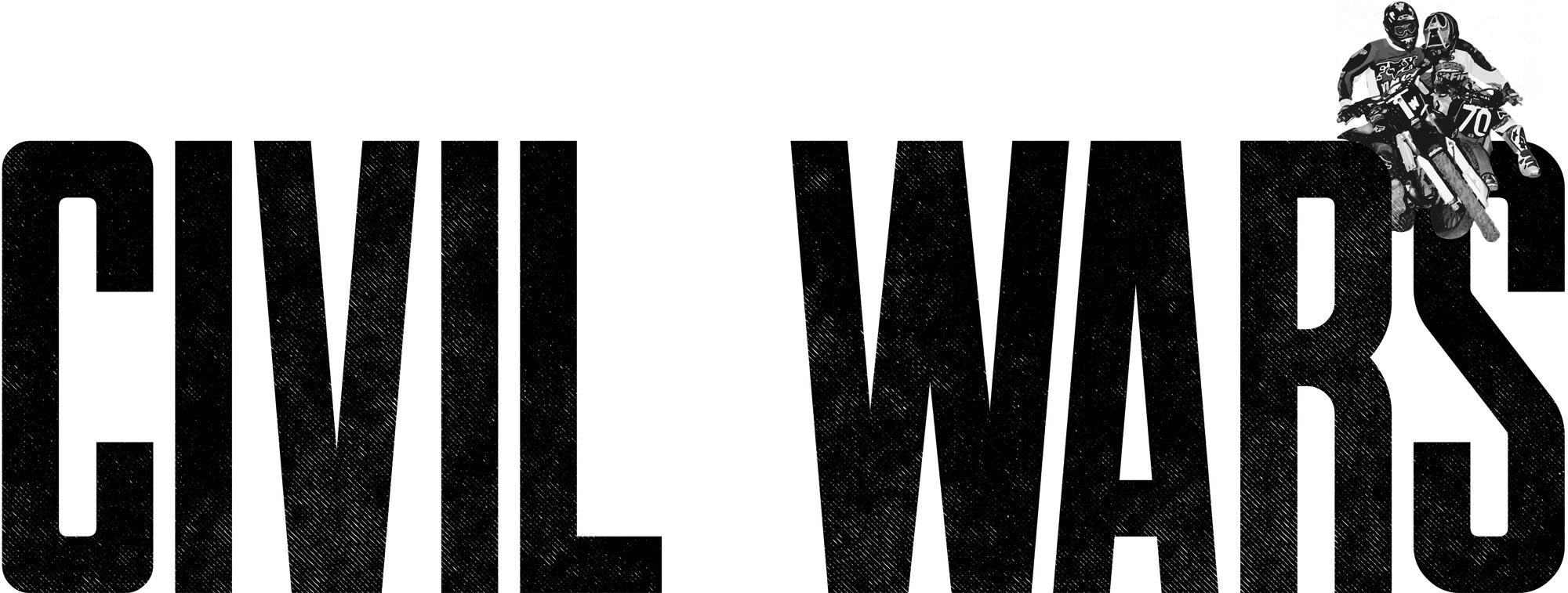
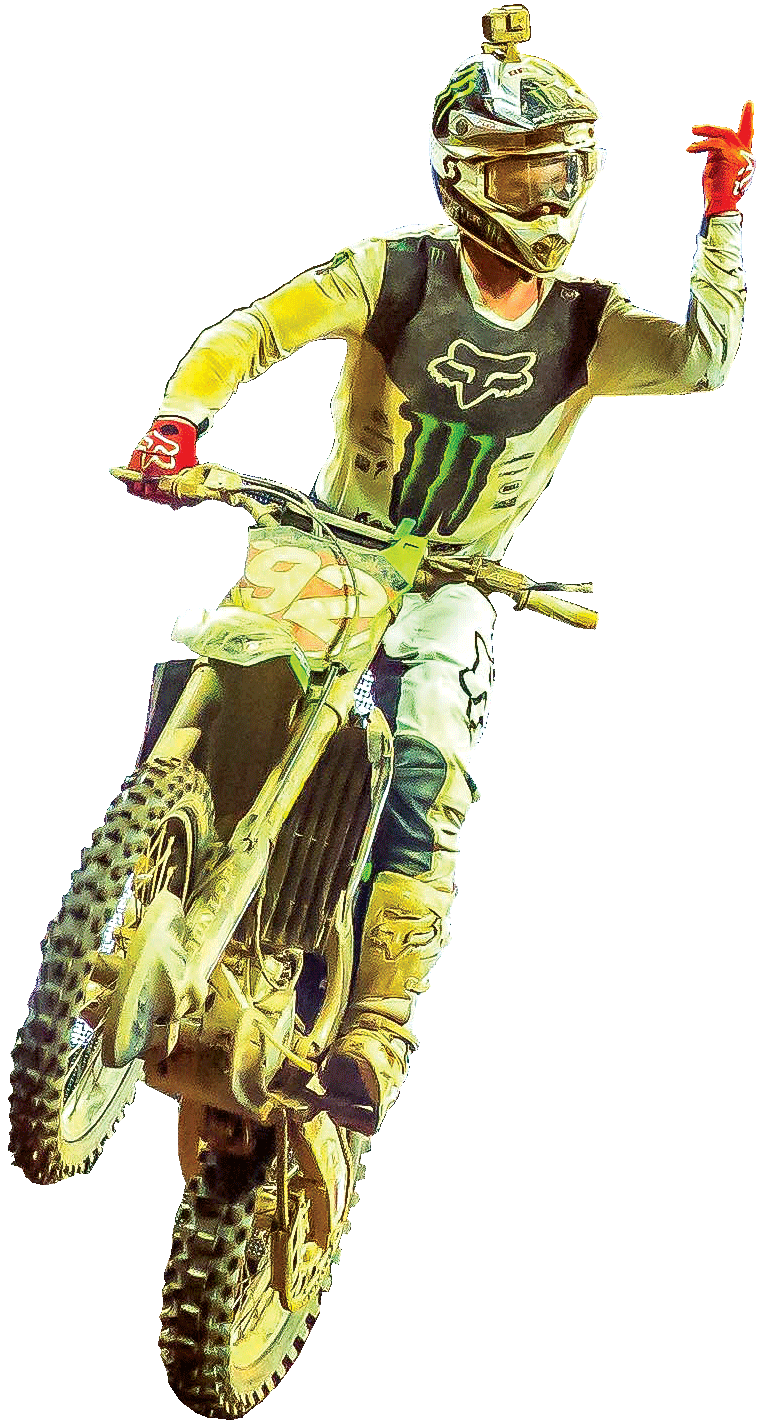
PHOTOS: RICH SHEPHERD & JEFF KARDAS

love the East-West races, because you’re racing everybody and if you win, you can say you beat them all,” Monster Energy/Pro Circuit Kawasaki’s Adam Cianciarulo said after winning this year’s first Showdown race in Atlanta, his third career win in an East-West event. But while Cianciarulo excels at the East-West races, a championship has eluded him throughout his career (though he is in the driver’s seat this time around).
“I’ve won the Vegas East-West finale twice, but both of those times I came up agonizingly short on the championship,” Adam says. “Though in 2017, the way that whole deal went down, I never thought I could possibly win it or whatever.” He’s referring to the three guys ahead of him in the points all struggling: Jordon Smith crashed out, Joey Savatgy melted down, and Zach Osborne crashed off the start, then caught Savatgy with two turns to go and knocked him down. Up until that dramatic moment, the winner Cianciarulo, already across the finish line, was going to claim an unlikely East Region Championship. It was Osborne instead, but Adam did earn a largely ceremonial title as the best 250SX rider when they all raced together: “I’d say it feels good to be the best Lites rider.” Just not a champion. Yet. But over the years, as the East-West concept evolved, lots of eventual champions have claimed Showdown wins (and, from 1997 until just last year, Shootout wins—more on that later).
The first 125 East-West race took place in the middle of the 1985 AMA Supercross Championship, the year that 125s were introduced as a class. The race was held at the Houston Astrodome and featured a couple of future FIM Motocross World Champions in Louisiana’s Chad (Trampas) Parker and California’s Bob Moore, both riding in the West Region. However, the race would be dominated by a pair of Easterners in Michigan’s Ed Warren and North Carolina’s Rodney Barr. (Finishing last in the main event with a broken shock was the only KTM in the field—the one I was riding!) The second was two weeks later at the old Texas Stadium in Irving, and this time Moore ended up winning on a Suzuki RM125. Bob would go on to win the first 125 West Region title, following in the footsteps of Warren, the Houston winner, who would take the first 125 East Region title.
In ’86, the two Texas races were again East-West, and again they were won by the respective champions, this time Honda riders Willie Surratt (West) and Keith Turpin (East). One year later, Houston would mark the start of the season, and the East-West Shootout could have been California vs. the other 49 states, as the race was dominated by West Region riders from the Golden State. As a matter of fact, each of the first seven finishers—Jeff Matiasevich, Mike Kiedrowski, Paul Winn, Kyle Lewis, Ty Davis, Mike Craig, and Chris Young—were all from California. The highest-finishing East rider, Pennsylvania’s Mike Jones, finished ninth!
California dominated the 125 class in 1990 too. When Jeff Emig won the Houston opener, the transplanted Missourian led a California sweep of the top four. That meant fifth-place Barry Carsten of New Jersey was the 125 East Region points leader following the opener. Things really got out of whack later that year at the Oklahoma City round, where each of the top six finishers were from the West, then came nine East riders, led by Suzuki-supported Grayson Goodman of Texas.
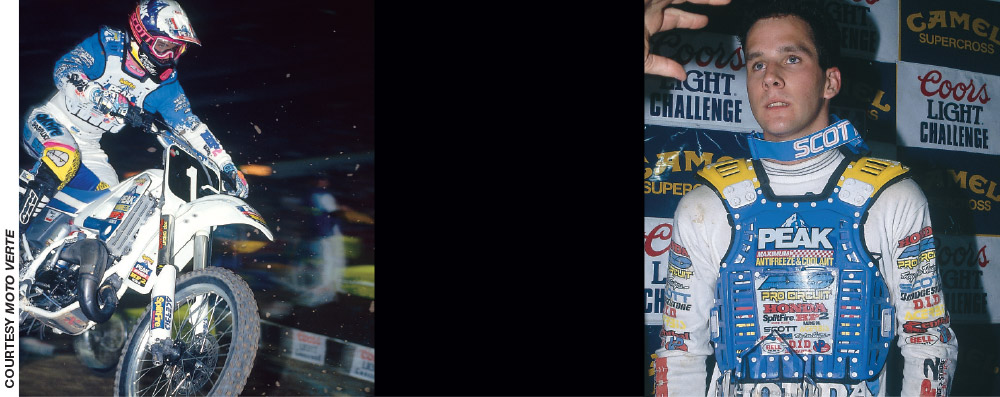

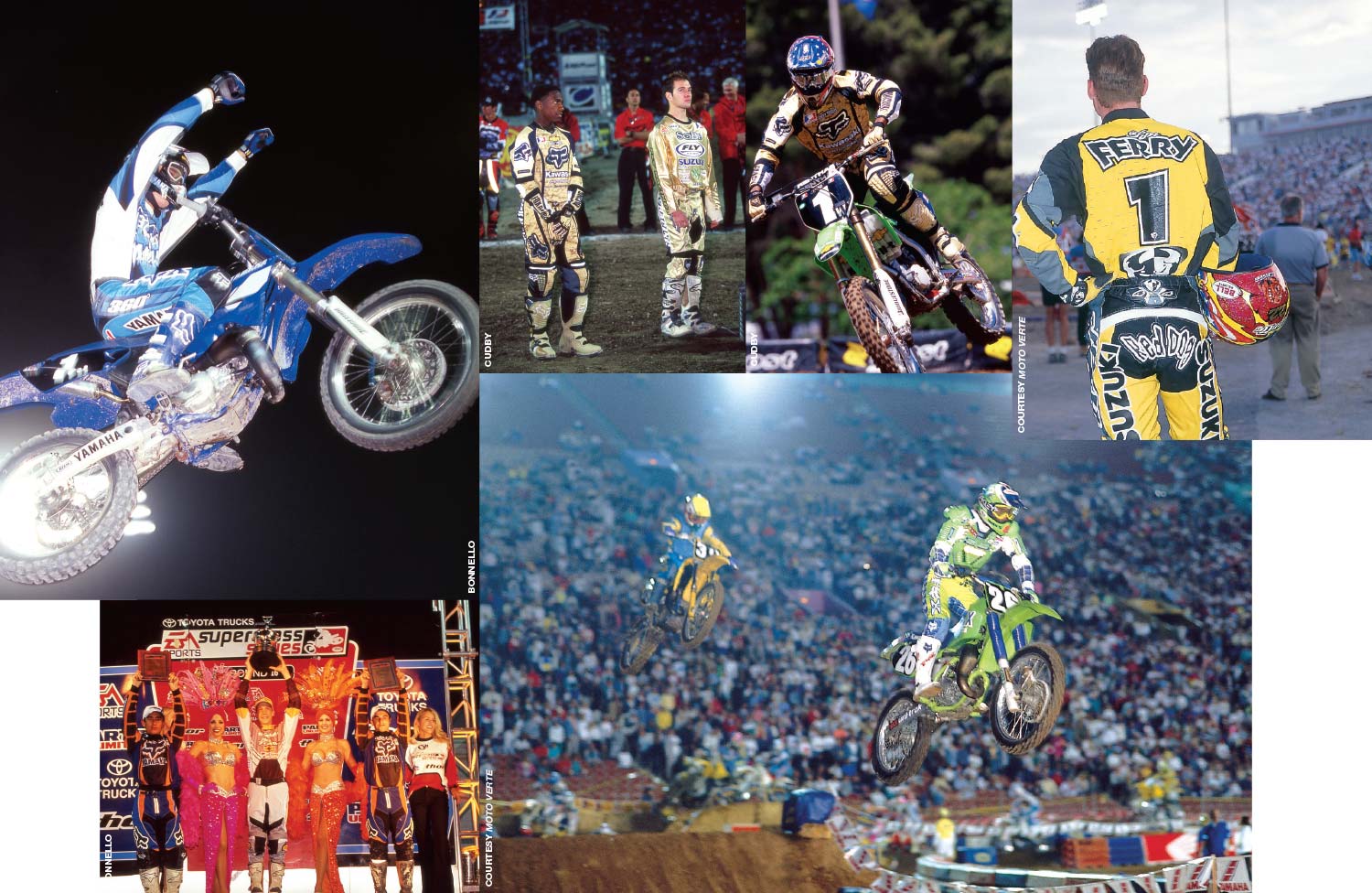

Swink and McGrath would have another showdown the following year, both wearing #1—only East champ Swink was on a Suzuki now. He gathered the win in Houston over DGY Yamaha rider Doug Henry and third-place McGrath. Jeremy would finally get even when he won the Dallas version of the Shootout race.
Over the years to follow, Payton’s riders would win numerous East-West matchups. Payton himself doesn’t think the whole series should be combined, though he would like to see more.
“We used to have up to three or four back in the day, and I think that would still work as something to spice it up a little,” Payton says. “The only thing with more of them would be we’d have to have four bikes constantly on the truck. We just get to the point where carrying everything is almost overweight. We’re barely able to carry four bikes for outdoors, so it makes it a pain in the butt.” When asked if he offers any different advice or strategy for for these races, Payton replies, “No. It’s probably the same. I think winning is a good idea, so pretty simple.”
One of Payton’s favorite memories of the East-West races came in the mid-nineties after he had imported French star Mickael Pichon for the East Region, at the same time Team Yamaha had Kevin Windham, who was getting started in the West.
“Windham was a friend who actually lived with me, but Pichon rode for me, so they would race each other and have these death battles, and then we’d come home and watch it on Sunday on the couch,” he recalls. “I’ve always liked the concept of East-West regions and the occasional showdown and don’t have a problem with any of it.”
Others might differ. If there were no East-West races but rather one complete series, these riders would be in the AMA record books with 125SX wins: Barry Carsten, Mike Jones, Grayson Goodman, Jeff Dement, and the late Tyler Evans.

love the East-West races, because you’re racing everybody and if you win, you can say you beat them all,” Monster Energy/Pro Circuit Kawasaki’s Adam Cianciarulo said after winning this year’s first Showdown race in Atlanta, his third career win in an East-West event. But while Cianciarulo excels at the East-West races, a championship has eluded him throughout his career (though he is in the driver’s seat this time around).
“I’ve won the Vegas East-West finale twice, but both of those times I came up agonizingly short on the championship,” Adam says. “Though in 2017, the way that whole deal went down, I never thought I could possibly win it or whatever.” He’s referring to the three guys ahead of him in the points all struggling: Jordon Smith crashed out, Joey Savatgy melted down, and Zach Osborne crashed off the start, then caught Savatgy with two turns to go and knocked him down. Up until that dramatic moment, the winner Cianciarulo, already across the finish line, was going to claim an unlikely East Region Championship. It was Osborne instead, but Adam did earn a largely ceremonial title as the best 250SX rider when they all raced together: “I’d say it feels good to be the best Lites rider.” Just not a champion. Yet. But over the years, as the East-West concept evolved, lots of eventual champions have claimed Showdown wins (and, from 1997 until just last year, Shootout wins—more on that later).
The first 125 East-West race took place in the middle of the 1985 AMA Supercross Championship, the year that 125s were introduced as a class. The race was held at the Houston Astrodome and featured a couple of future FIM Motocross World Champions in Louisiana’s Chad (Trampas) Parker and California’s Bob Moore, both riding in the West Region. However, the race would be dominated by a pair of Easterners in Michigan’s Ed Warren and North Carolina’s Rodney Barr. (Finishing last in the main event with a broken shock was the only KTM in the field—the one I was riding!) The second was two weeks later at the old Texas Stadium in Irving, and this time Moore ended up winning on a Suzuki RM125. Bob would go on to win the first 125 West Region title, following in the footsteps of Warren, the Houston winner, who would take the first 125 East Region title.
In ’86, the two Texas races were again East-West, and again they were won by the respective champions, this time Honda riders Willie Surratt (West) and Keith Turpin (East). One year later, Houston would mark the start of the season, and the East-West Shootout could have been California vs. the other 49 states, as the race was dominated by West Region riders from the Golden State. As a matter of fact, each of the first seven finishers—Jeff Matiasevich, Mike Kiedrowski, Paul Winn, Kyle Lewis, Ty Davis, Mike Craig, and Chris Young—were all from California. The highest-finishing East rider, Pennsylvania’s Mike Jones, finished ninth!
California dominated the 125 class in 1990 too. When Jeff Emig won the Houston opener, the transplanted Missourian led a California sweep of the top four. That meant fifth-place Barry Carsten of New Jersey was the 125 East Region points leader following the opener. Things really got out of whack later that year at the Oklahoma City round, where each of the top six finishers were from the West, then came nine East riders, led by Suzuki-supported Grayson Goodman of Texas.


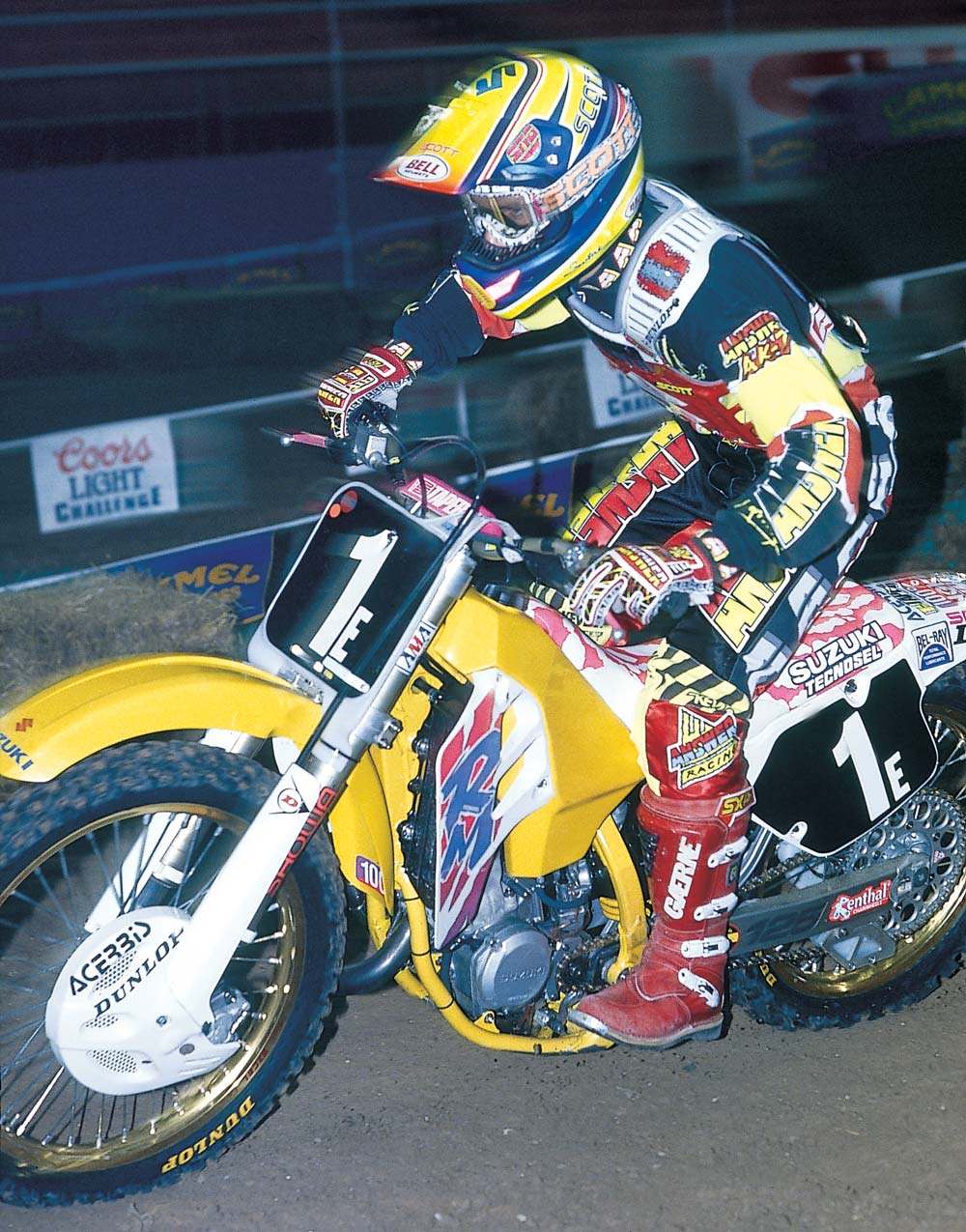


Swink and McGrath would have another showdown the following year, both wearing #1—only East champ Swink was on a Suzuki now. He gathered the win in Houston over DGY Yamaha rider Doug Henry and third-place McGrath. Jeremy would finally get even when he won the Dallas version of the Shootout race.
Over the years to follow, Payton’s riders would win numerous East-West matchups. Payton himself doesn’t think the whole series should be combined, though he would like to see more.
“We used to have up to three or four back in the day, and I think that would still work as something to spice it up a little,” Payton says. “The only thing with more of them would be we’d have to have four bikes constantly on the truck. We just get to the point where carrying everything is almost overweight. We’re barely able to carry four bikes for outdoors, so it makes it a pain in the butt.” When asked if he offers any different advice or strategy for for these races, Payton replies, “No. It’s probably the same. I think winning is a good idea, so pretty simple.”
One of Payton’s favorite memories of the East-West races came in the mid-nineties after he had imported French star Mickael Pichon for the East Region, at the same time Team Yamaha had Kevin Windham, who was getting started in the West.
“Windham was a friend who actually lived with me, but Pichon rode for me, so they would race each other and have these death battles, and then we’d come home and watch it on Sunday on the couch,” he recalls. “I’ve always liked the concept of East-West regions and the occasional showdown and don’t have a problem with any of it.”
Others might differ. If there were no East-West races but rather one complete series, these riders would be in the AMA record books with 125SX wins: Barry Carsten, Mike Jones, Grayson Goodman, Jeff Dement, and the late Tyler Evans.




ultiple East-West races would be in each season until 1997, when it was decided that each region would run along until the finale, which had just moved to Las Vegas. As part of a tourism deal with the city, it was decided that the ’97 finale would be the only showdown race, and the name would be changed to the East-West Shootout. No points would be awarded to either region; rather it was a standalone race for bragging rights. And the first one would become one of the most famous match races of all, with rookie sensation Ricky Carmichael taking on two-time 125cc West Region champ Windham for the first time in their professional careers.
“This is the only chance we’ve had all year for the two regions to compete,” Windham told Cycle News. “Everybody’s been talking about this for so long I was a little bit nervous coming into it. There was a lot of pressure from all the pre-race hype.”
After gating up front together, the Yamaha-backed Windham stalked Pro Circuit Kawasaki’s Carmichael before finding an opening, then shooting past and blocking RC’s line.
“I made a pretty aggressive pass on him,” Windham said afterward. “I didn’t make any contact, but I shut him down from doing a triple.” Carmichael immediately responded with a full-on T-bone pass on Windham, which was captured on film by Dirt Rider magazine’s Ken Faught. “He came back with a big surprise on me. He rode me in real high and hit me pretty good. He was ready and he wanted the win bad, too. It was definitely a good pass, and it teaches me what to expect of him. I’ve never really raced him that close before.”
“He kind of cut me off and passed me, which was good,” Carmichael said after the race. “I mean, I would have done the same. I came back in there and kind of hit him, got in front of him.” Unfortunately, the rookie ended up bobbling in the whoops and crashing, which was typical of his freshman year in supercross. Carmichael then crashed again and ended up a lowly 18th while Windham ran away from everyone else.
“This was the one and only chance I had, and I pulled through,” Windham said. “I really cared about this race because we started so close together. That was one of the most important things about this race—I wanted to make sure there were no excuses.”
Needless to say, Carmichael never forgot about the first big defeat of his career. There would not be many more. And the very next year, the future GOAT would cement the one and only undefeated season in 125cc supercross history by dominating the East-West Shootout in Las Vegas.
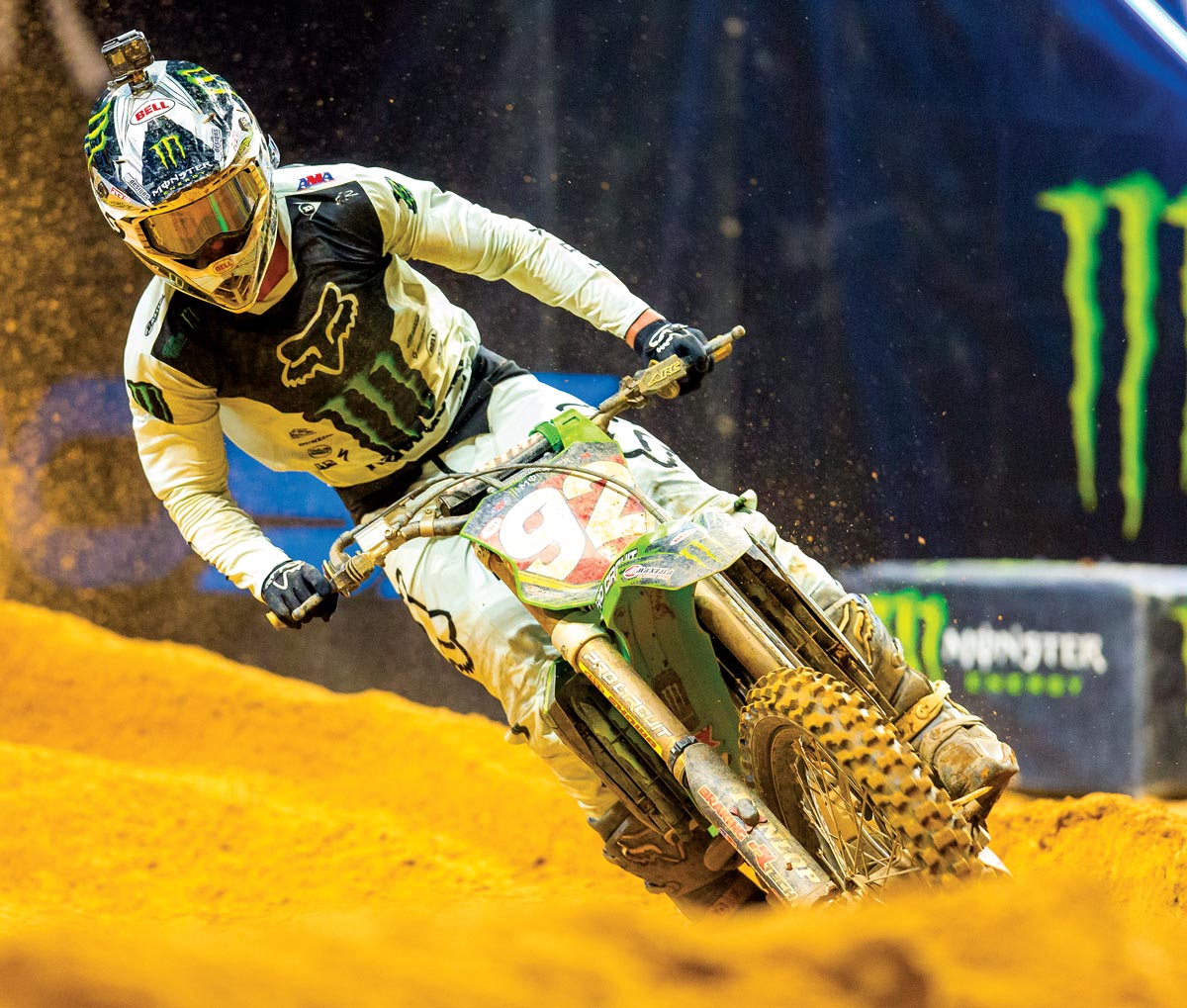
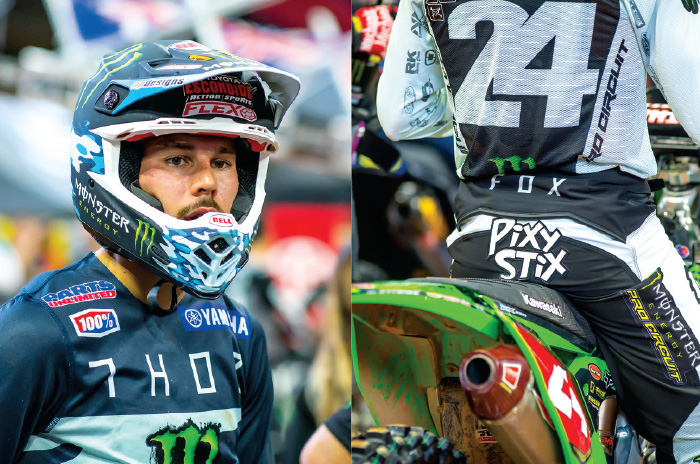
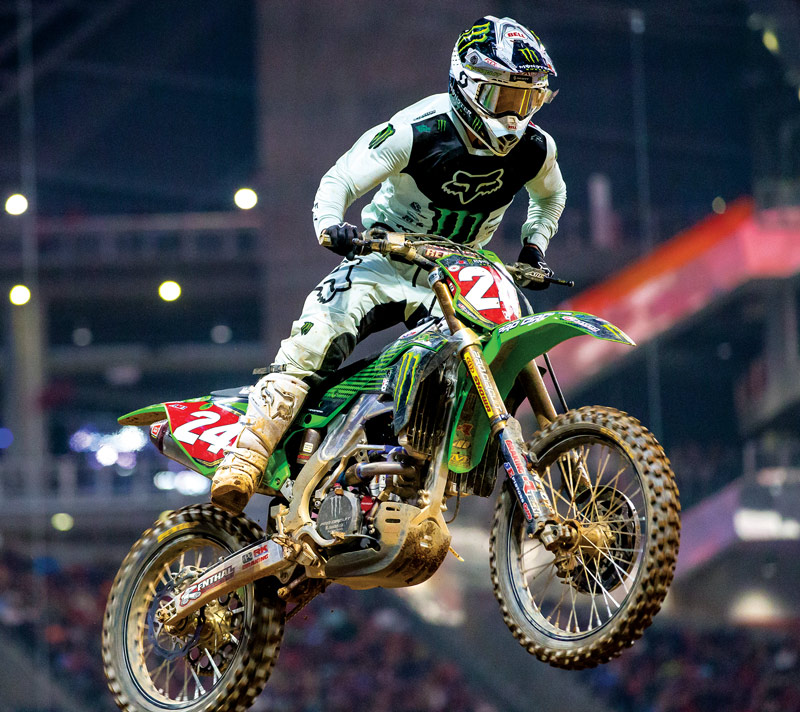
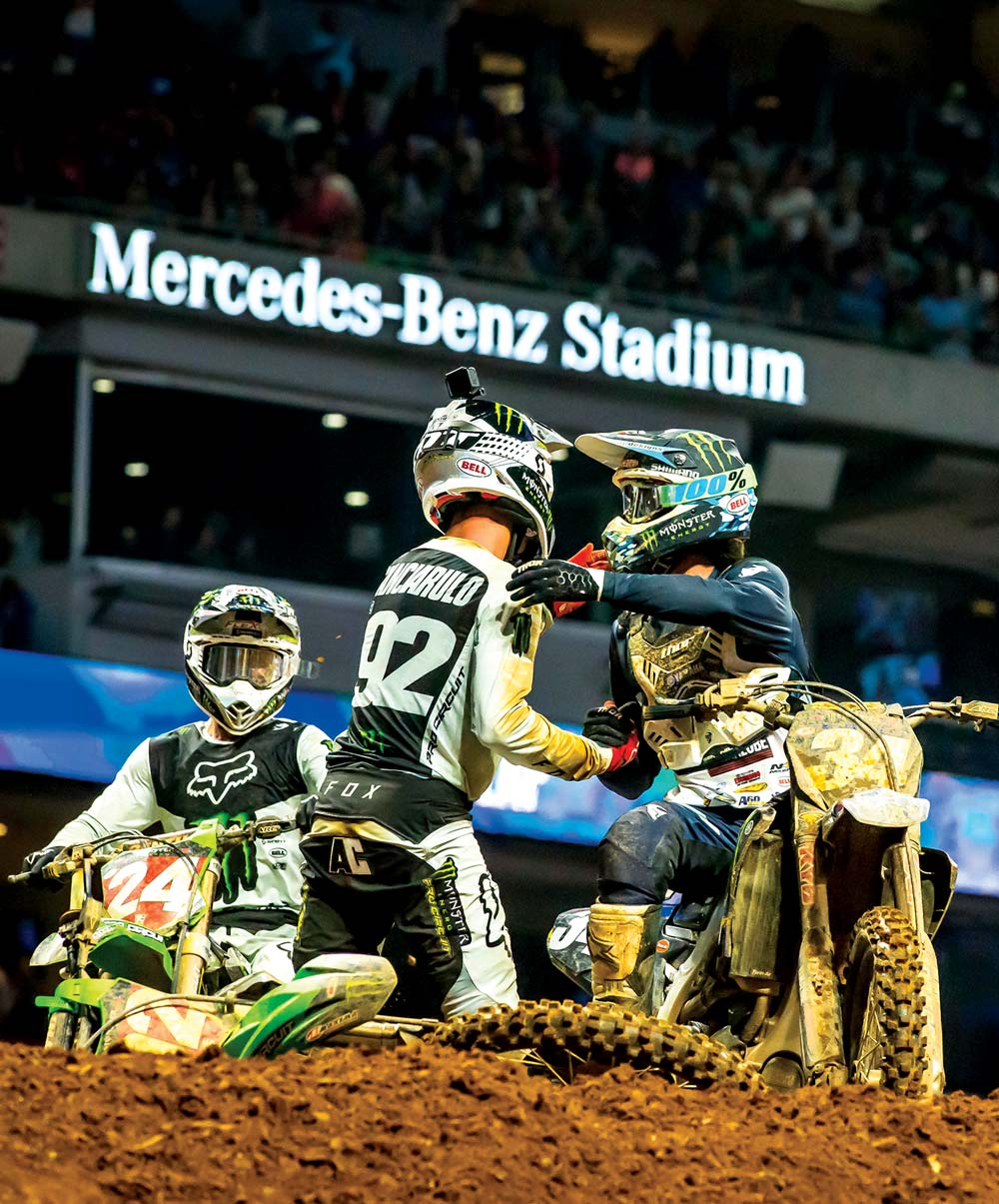

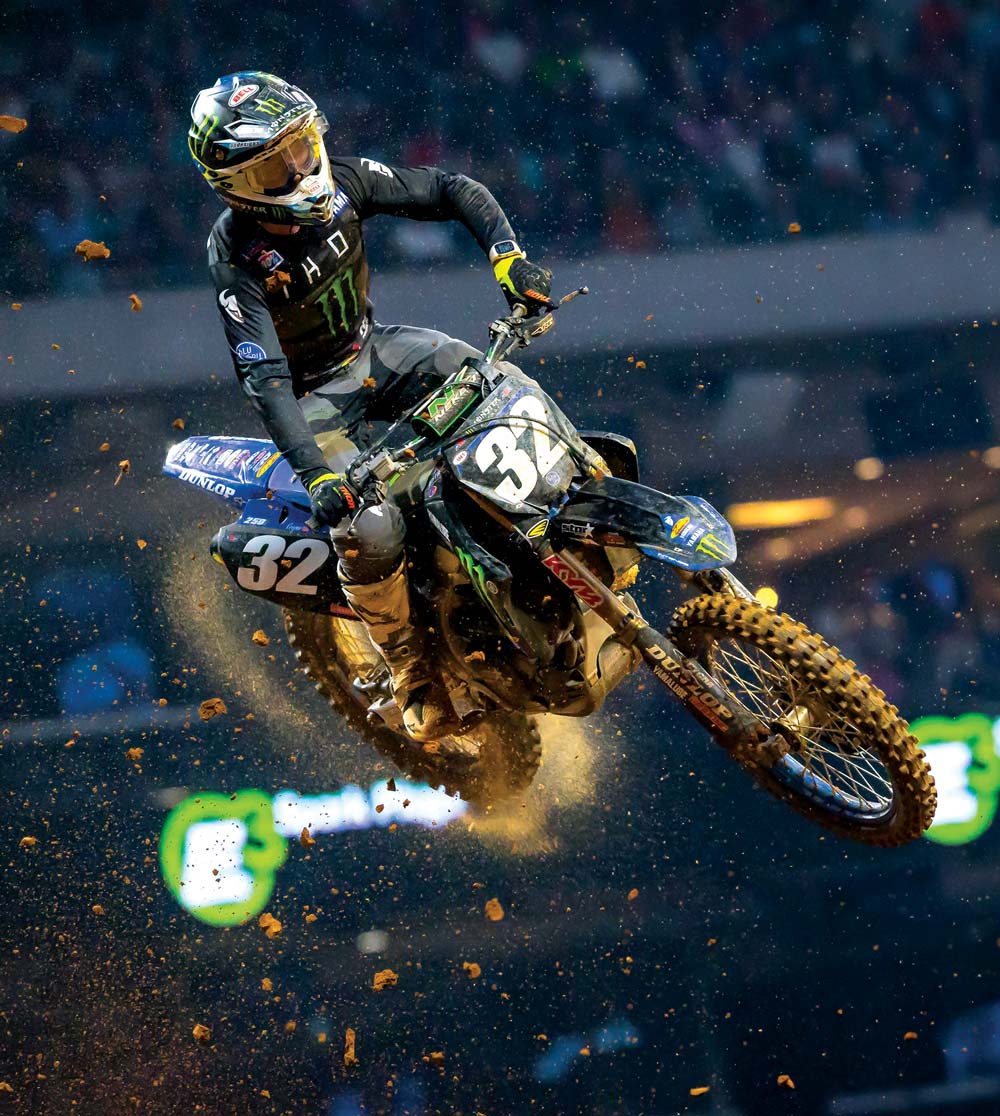
t wasn’t long before the East-West Shootout in Las Vegas began to lose some of its luster, in part because it started taking a toll on the riders, costing many their title shots at the soon-to-begin outdoor nationals. In 2003, both the 125 West (Stewart) and the 125 East (Jesseman) Champions got hurt, Jesseman breaking his wrist on press day and Stewart breaking his collarbone in a spectacular crash while leading. Stewart would avenge himself the next year, beating Stephane Roncada, who put in maybe the ride of his life. This was also the last time a 125cc two-stroke would ever win a supercross main event.
In 2006, Pro Circuit Kawasaki’s Grant Langston separated his thumb on press day, and in ’07, teammates Ryan Villopoto and Ben Townley, wearing #1W and #1E, respectively, finished right next to one another—next-to-last and dead last—after having first-lap trouble in the Vegas Shootout. Townley’s chain fell off and RV lost his back brakes after getting hit in the first turn.
In 2011, they tried another tweak: have an East and a West main event that both counted in the series standings, and then a standalone Shootout for everyone racing together. Blake Baggett and Ken Roczen won their respective mains, but then Star Racing Yamaha’s Ryan Sipes won the actual Shootout. A similar situation happened in ’13, with Tyler Bowers and Eli Tomac winning the Regional mains and Roczen winning the Shootout. Feld Entertainment eventually realized that having four different main-event winners (including the 450SX class) in one program was confusing.
Which brings us to today’s current format, as well as the additional rounds. Feld and the AMA finally settled on having heat races—one for the East, one for the West—where the top nine go to the main event. Everyone else goes to the LCQ, where four more make the main. The racing proved so successful and entertaining after “that whole deal” in Las Vegas in 2017 that Indianapolis ’18 was designated an “East-West Showdown,” followed by the annual Shootout in Las Vegas, which was again won by Cianciarulo. If things continue the way they’ve been going, Adam should feel good about both his Shootout chance and, finally, a real title shot. 




